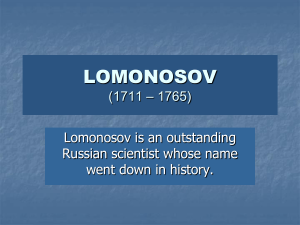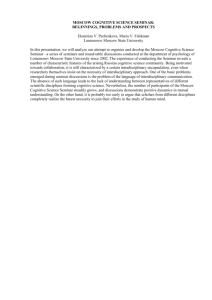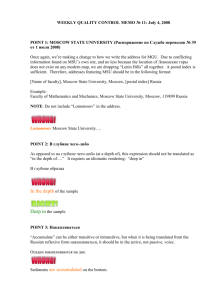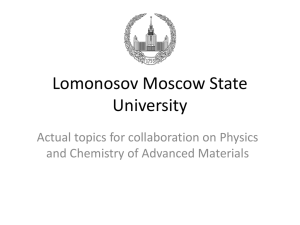Pilipenko - Viessmann European Research Centre
advertisement
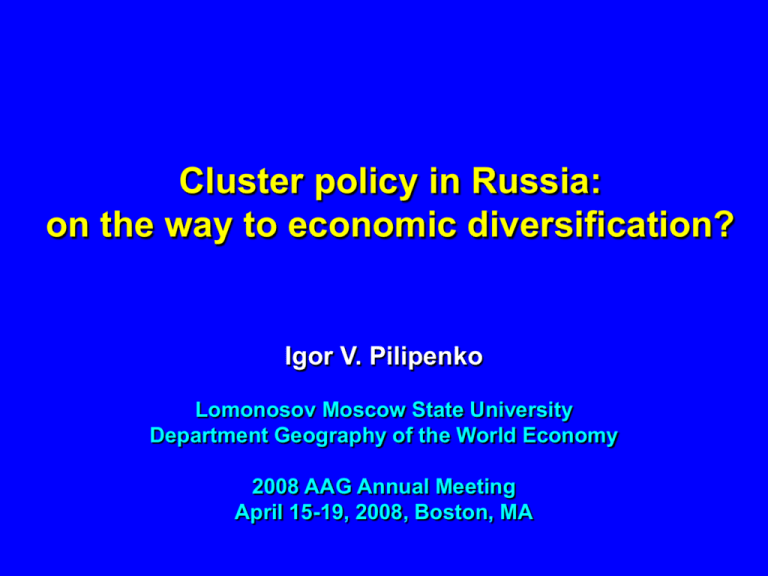
Cluster policy in Russia: on the way to economic diversification? Igor V. Pilipenko Lomonosov Moscow State University Department Geography of the World Economy 2008 AAG Annual Meeting April 15-19, 2008, Boston, MA Сluster policy – definition (I) A new way of microeconomic policy implementation involving government, business, educational and scientific community. (discussed by Sölvell, Lindqvist, Ketels, 2003; Andersson, Hansson, Serger, Sölvik, 2004) Clusters are new policy objects – 2 general types of clusters: • Non-spatial clusters (industrial, national) – a group of interrelated, adjacent industries and services that successfully specialise in the international division of labour; • Spatial clusters (regional, local, transborder) – groups of geographically concentrated enterprises in regions or localities from adjacent industries and services, which produce similar or inter-supplemental goods and services using mostly external economies of scale (local division of labour, local pool of labour force, innovation diffusion). April 16, 2008 Igor V. Pilipenko Lomonosov Moscow State University 2 Сluster policy – definition (II) Cluster policy involves tools from other policies or is a part of other policies at a regional/local level: • tax incentives, • regional branding (Standort-Marketing), • FDI attraction, etc. Cluster policy genesis: (discussed by Ffowcs-Williams, 2004) • Top-down policy (initiated from government); • Bottom-up policy (started by business community); • Mixed policies (both parties initiate cluster policy). April 16, 2008 Igor V. Pilipenko Lomonosov Moscow State University 3 Possible cluster policy targets in the Russian economy: 1. Stimulation of competition and exports diversification; 2. Fostering studies of firm development at the regional/local level and elaboration of specially focused programs; 3. Creation of favorable environment for SMEs development; 4. Strengthening cooperation between government, business, educational and scientific communities. April 16, 2008 Igor V. Pilipenko Lomonosov Moscow State University 4 Competition in the Russian economy World Bank/HSE survey 2005/2006 ~ 1,000 enterprises no competition – 20%: • max – wood processing 31%, • min – textile manufacturing 12%. competition with only domestic enterprises – 30%: • max – food processing 42%, • min – chemicals 17%. competition with only foreign enterprises – 13%: • max – textile manufacturing 25%, • min – food processing 5%. competition with both types of enterprises – 37%: • max – chemicals 53%, • min – automotive industry 26%. April 16, 2008 Igor V. Pilipenko Lomonosov Moscow State University 5 Russia’s exports diversification The share of 10 leading export products in total exports (INTRACEN) has increased from 76 to 79% in 2001-2005; The share of “mineral products” group (according to Rosstat’s definition) has increased from 53.8 to 65.9%; The share of “vehicles and its parts” group (Rosstat) decreased from 8.8 to 5.8%. April 16, 2008 Igor V. Pilipenko Lomonosov Moscow State University 6 Microeconomic approach and regional development (I) Regional policies despite Russia’s vast territories have been surprisingly considered of second priority after macroeconomic stability; Ca. 11 versions of “The Concept of regional development in Russia” were elaborated; the last proposed version was approved by the Government in 2005; The role of regional development topics in the current strategic planning: • “The Concept of Social-Economic Development of the Russian Economy until 2020” (the version of October 2007) – 15 pages about regional development (171 pages in total); • “The Concept 2020” in March 2008 – 28 pages about regional development from 165 pages in total). April 16, 2008 Igor V. Pilipenko Lomonosov Moscow State University 7 Microeconomic approach and regional development (II) Overall productivity in Federal districts, 2000 and 2004 Southern FD 4438 2010 Volga FD 2826 Siberian FD 2914 5996 6873 Far-Eastern FD 3534 Russia, average 3442 North-Western FD 3298 Central FD 7538 7884 7905 9055 4135 Ural FD 15524 5856 0 2000 4000 6000 8000 10000 12000 14000 16000 18000 Overall productivity, GDP per person employed 2000 2004 The productivity difference between Ural FD and Southern FD: 2000 – 2.9 times; 2004 – 3.5 times. April 16, 2008 Igor V. Pilipenko Lomonosov Moscow State University 8 Microeconomic approach and regional development (III) The range between regions with highest and lowest overall productivity (GDP per person employed): 2000 21,485 925 23 Nenets AO Rep. Dagestan Range (times) 2004 Nenets AO 56,012 Rep. Adygeya 3,102 Range (times) 18 The range between 10 regions with highest and lowest overall productivity (GDP per person employed): 10 leading regions 10 lagging regions Range (times) April 16, 2008 2000 10,445 1311 7.9 2004 10 leading regions 26,577 10 lagging regions 3,266 Range (times) 8.1 Igor V. Pilipenko Lomonosov Moscow State University 9 Microeconomic approach and regional development (IV) Regional productivity distribution, 2004 GDP per person employed 60000 50000 40000 30000 20000 Nenets AD 56,012 Khanty Mansi AD 52,554 Yamal Nenets AD 42,377 Tyumen' oblast ' 36,519 Moscow 16,327 X 7,884 St.Petersburg 7,730 Me 5,375 10000 0 regions April 16, 2008 Igor V. Pilipenko Lomonosov Moscow State University 10 SMEs definition in Russia Prior to 2007 no definition of SMEs in statistics; Since 1995 - definition of small enterprises: No. of employees varied between 30 and 100 depending on industry, Government/religious organizations’ share < 25% Self-employment is included. Since January 1, 2008 – definition of SMEs: Medium-sized – less than 250 employees, Small – less than 100 employees, Micro-enterprises – less than 10 employees. Self-employment is included. In 1980 in USSR an average employment in manufacturing was ca. 330 employees (Baklanov, 1986). In 2005 in Russia an average employment in the whole economy was less than 15 employees (Rosstat). April 16, 2008 Igor V. Pilipenko Lomonosov Moscow State University 11 Small business (SB) demography in Russia employment – 17.8% (2006); national value-added – 11.8% (2004). SB distribution by industry, as of January 1, 2007: SB share in: April 16, 2008 Igor V. Pilipenko Lomonosov Moscow State University Source: Ministry of Economic Development and Trade 12 The model of spatial interaction between government, SMEs, large enterprises, education and scientific institutions within a regional innovation system A region Implementation of a regional innovative policy Creation of knowledge in educational and scientific institutions Implementation of innovations in technology, science parks, etc. innovations Innovative production in clusters of small and medium enterprisers goods Influence of TNCs A transnational corporation April 16, 2008 Influence of TNCs Value-added chain Igor V. Pilipenko Lomonosov Moscow State University A transnational corporation 13 Challenges for cluster policy implementation in Russia Notions “cluster” and “cluster policy” are often incorrectly interpreted; No final goals settings (i.e. raising productivity, exports, creation of new jobs); No drivers of SMEs competitiveness identified (external economies of scale, etc.); Confusion of notions – cluster vs. territorial-production complex (often in regional development strategies); cluster vs. technology park or industrial districts; April 16, 2008 Igor V. Pilipenko Lomonosov Moscow State University 14 Development of the theory of territorial-production complexes (TPCs) 1920s – Creation of theory of economic region economic region = TPC 1950s – Creation theory of energy-production cycles as basis of TPCs 1970s-1980s – Paradigm “Shift to East”, practical spatial application of TPC models in Eastern regions of USSR Late 1970s-1980s – Application of TPC models in developing nations and countries of Central and Eastern Europe April 16, 2008 Igor V. Pilipenko Lomonosov Moscow State University 15 Main territorial-production complexes in Russia, since 1980s Timan-Pechora North-Tyumen’ West-Yakut Noril’sk South-Yakut Lower Angara Kursk Magnetic Anomaly Bratsk-Ust’-Ilimsk Middle-Ob’ Irkutsk-Cheremkhovo Kuzbass Krasnoyarsk Sayany April 16, 2008 10 Siberian TPCs accounted in 2006 for 17% in country’s manufacturing and 25% in national exports Igor V. Pilipenko 16 (Bezrukov, 2006) Lomonosov Moscow State University The classification of spatial forms of R&D and production organization Prevailed size of enterprises Type of creation Small and medium enterprises Ib Small, medium, and large enterprises II b Medium and large enterprises III b Large enterprises IV b Developed themselves / localization economies Ia - Marshallian industrial district - Italian industrial district - Regional cluster - Local cluster - Hub-and-spoke industrial district - State-anchored industrial district - Regional cluster - Satellite platform district - Vertically integrated industrial plants (often in old industrial regions) Created artificially by state authorities - Technology park - Science park - Business innovation centre - Innovation technological centre - Technopolis - Territorialproduction complex - Territorialproduction complex - Territorialproduction complex II a April 16, 2008 Igor V. Pilipenko Lomonosov Moscow State University 17 Four directions of cluster policy towards four various objects: Non-spatial clusters – already exist and can be easily identified: oil&gas industries, metallurgy, military complex, aerospace industry; Territorial-production complexes – already exist (the plants are mostly private-owned) or were planned in USSR; Spatial clusters – possible emerging within agglomerations with scientific and basic infrastructure in new industries developing since 1991 with a larger share of SMEs – ICT, services, new construction materials, consumer-oriented industries; Cluster initiatives – some examples. i.e. in automotive industry are found. April 16, 2008 Igor V. Pilipenko Lomonosov Moscow State University 18 Cluster policy direction 1: non-spatial clusters Responsibility: federal government; Type of policy: creation of a favorable and innovation-stimulative framework, promotion of cluster companies abroad; raising educational and technological standards; Form of realization: mostly lawmaking; Theoretical background: the schools of the competitiveness theory. April 16, 2008 Igor V. Pilipenko Lomonosov Moscow State University 19 The analysis of the competitiveness theory creation The problem of national competitiveness The theory of international trade The location theory The human capital theory We analyzed ca. 40 theories and concepts elaborated by scholars from 10 nations April 16, 2008 Igor V. Pilipenko Lomonosov Moscow State University 20 We identify three main schools of the competitiveness theory: 1. The American School – M. Porter, M. Enright, et.al. The most practically-oriented school: the diamond of competitive advantages, industrial and regional clusters 2. The British School - J. Dunning, R. Kaplinsky, J. Humphrey, H. Schmitz, C. Freeman et.al. Division of labour between developed and developing countries: value-added chains, clusters, transnational corporations, techno-economic paradigm 3. The Scandinavian School - B.-A. Lundvall, B. Johnson, B. Asheim, A. Isaksen, E. Reinert et.al. The social-economic school: national systems of innovation, regional innovation systems, the learning economy, learning region, types of knowledge April 16, 2008 Igor V. Pilipenko Lomonosov Moscow State University 21 First steps in cluster policy realization towards non-spatial clusters Creation of large government-owned enterprises in highly monopolized industries in the world economy: “OAO United Aircraft Corporation” (11 enterprises) in 2006; “OAO United Shipbuilding Corporation” in 2007; Creation of State Corporations (as legal entities – nonprofit organizations) in 2007: Russian Corporation of Nanotechnologies; Russian Technologies; ROSATOM; etc. April 16, 2008 Igor V. Pilipenko Lomonosov Moscow State University 22 Cluster policy direction 2: territorial-production complexes Responsibility: federal government – strategic planning; regional government – project realization. Type of policy: creation of new TPCs, diversification of already existed TPC, realization of infrastructure projects; Form of realization: mostly public-private partnership; Theoretical background: TPC-approach. April 16, 2008 Igor V. Pilipenko Lomonosov Moscow State University 23 Cluster policy direction 3: spatial clusters Responsibility depending on cluster size: regional government; local government. Type of policy: creation of firm networks, broker policy, regional branding, educational and training programs, diversification of demand, creation of favorable conditions; Form of realization: public-private partnership, lawmaking, promotion of cluster companies abroad, exhibitions; Theoretical background: the schools of the competitiveness theory. April 16, 2008 Igor V. Pilipenko Lomonosov Moscow State University 24 Location of Novosibirsk April 16, 2008 Igor V. Pilipenko Lomonosov Moscow State University 25 Local ICT-cluster in Novosibirsk Year of formation – 1992 Number of firms – over 20 from total 150 enterprises Number of employees – ca. 2,000 Turnover of cluster firms – over $30 mln (2003) Specialization – offshore programming, software production, consulting and OEM In larger scientific centres as Moscow (over 70 ICT-enterprises) and St.-Petersburg (over 50 ICT-enterprises) – also potential ICT-clusters April 16, 2008 Igor V. Pilipenko Lomonosov Moscow State University 26 Main characteristics of a local cluster in Novosibirsk: • Cluster firms: – are from one industry; – are geographically concentrated; – have close contacts with research institutes from the Scientific city of Novosibirsk (Naukograd); – have close contacts with Novosibirsk State University; – have close contacts with Novosibirsk Technology Park. • Intensive information and know-how exchange between firms and their personnel; • Decision-making centre was in this cluster – the leading firm “Novosoft”. April 16, 2008 Igor V. Pilipenko Lomonosov Moscow State University 27 Cluster policy direction 4: cluster initiatives Responsibility: mainly local governments; Type of policy: creation of firm networks, deepening cooperation between government, enterprises and academia, broker policy, regional branding, educational programs, diversification of demand, creation of favorable conditions; Form of realization: public-private partnership, promotion of cluster companies abroad, exhibitions; Theoretical background: the schools of the competitiveness theory. April 16, 2008 Igor V. Pilipenko Lomonosov Moscow State University 28 Thank you! Igor V. Pilipenko Lomonosov Moscow State University Department Geography of the World Economy igor_pilipenko@yahoo.com www.i-pilipenko.narod.ru
